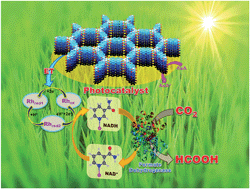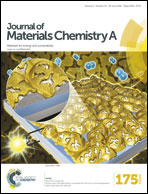A highly efficient covalent organic framework film photocatalyst for selective solar fuel production from CO2†
Abstract
Two-dimensional covalent organic frameworks (2D COFs) are a class of crystalline polymers with a design controllable platform that may be developed into a new type of metal-free photocatalyst. The exploration of new frameworks is, however, critical for further progress in this emerging field. To realize their full potential in practical light harvesting applications, the fabrication of a film type photocatalyst is equally essential. Here, we report the successful development of a triazine based covalent organic framework (2D CTF) as an inexpensive and highly efficient visible light active flexible film photocatalyst for solar fuel production from CO2. For this research work, the condensation polymerization between cyanuric chloride and perylene diimide has been exploited for the first time as a new synthetic approach to the construction of 2D CTFs. The visible light-harvesting capacity, suitable band gap and highly ordered π electron channels contribute to the excellent performance of the film photocatalyst. The current study is a benchmark example of COF based photocatalysts for solar fuel production from CO2 and is expected to trigger further interest in potential solar energy conversion applications such as wearable devices.


 Please wait while we load your content...
Please wait while we load your content...